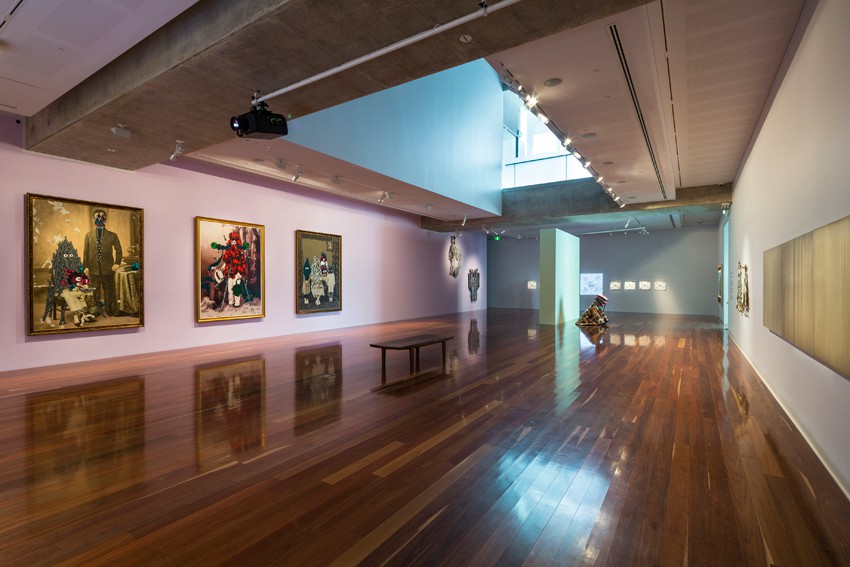Mooi Indie

The OzAsia exhibition Mooi Indie dismisses any preconceived notions about contemporary Indonesian art.
The OzAsia exhibition Mooi Indie dismisses any preconceived notions about contemporary Indonesian art. With Indonesia being one of Australia’s closest neighbours it’s surprising how little we have seen of contemporary Indonesian art. With awareness and interest growing, the current exhibition Mooi Indie – Beautiful Indies: Indonesian Art Now at Samstag Museum of Art is timely. Curator Matthias Arndt presents the largest exhibition of its kind in Australia to date and dismisses any preconceived notions we might have about contemporary Indonesian art. The exhibition includes work by Jumaldi Alfi, Eko Nugroho, Wedhar Riyadi, Arin Dwihartanto Sunaryo, Entang Wiharso and the Tromarama group in a variety of media from volcanic ash paintings and video works to embroideries and aluminium cutouts. “The idea is to give an overview and introduce the depth of Indonesian art, which is not only street art related or more expressive in style, but it also has many conceptual sides like the work of Tromarama and Sunaryo.” ‘Mooi Indie’, is a Dutch term for ‘beautiful indies’ referencing the late 19th century/early 20th century movement led by foreign artists in Indonesia during colonisation. It was first used as the title of a series of reproductions of watercolours by the Dutch artist Fredericus Jacobus van Rossum du Chattel (1856-1917) depicting romanticised views of Indonesia. “It was the Germans, the Belgians, the Dutch artists that started Mooi Indie, this idealisation of Indonesia as a primitive country while it was being exploited and colonised. For them it was a paradise of free artistic expression,” explains Arndt. One of the most important visual artists before and during independence, Sindu Sudjojono (1913-1986), rejected the Mooi Indie movement as an idealised view of the colonial period and not a true representation of Indonesian society. The phrase now, in a sense, recognises the colonisation of Indonesia’s art history as much as the colonial period itself. The artists Arndt has selected are attempting to re-write this history by embracing concepts and ideas of traditional Indonesian art but presenting them in a modern context. “Each artist shows, in a different way, that their home and background is Indonesian. Each artist clearly has their own background and story and gets their material from Indonesia but emphasises the multi-layered culture that is there and reclaims their identity as a contemporary Indonesian artist,” explains Arndt. Sunaryo, for instance, grew up in Bandung, where most of the conceptual art of Indonesia comes from, and then went on to study at St Martin’s College in London. “An Indonesian artist with total Indonesian upbringing goes to London to free himself and is trained and brings that back to take quite literally the soil of his country to make his paintings.” The work Ashfall no. 4 is created using volcanic ash, pushing the boundaries of painting and presenting an image, which uses the soil of Indonesia but because of its minimalist structure, could be the work of a western artist. At first glance Alfi’s work from the series Melting Memories – Rereading Landscape Mooi Indie looks as if he has taken a Mooi Indie painting and collaged or mounted it onto a blackboard but on closer inspection you realise it’s all painted. “By doing this, he says, ‘Now we study this again, now we go through this again’. Basically he reclaims this foreign influence on the history of art of Indonesia,” says Arndt. Riyadi’s works from the series Noise from the fertile land are also striking. He takes found portraits of Indonesians in western poses and dress and recreates them adding his trademark cartoon imagery. The works make reference to old versus new, and traditional versus modern. Also interesting are the stop-motion animation works by the artist collective Tromarama, formed in 2006 by Febie Babyrose, Ruddy Hatumena and Herbert Hans. The works bring to life traditional objects like porcelain plates and napkins, as if the images have jumped straight off the object onto the screen, thrusting them back into the contemporary limelight. Mooi Indie is just a snapshot of the fascinating art coming out of the region. Arndt says: “The reason I am putting this exhibition together is to show that art is a universal language and art from Indonesia is authentic, it’s engaged, it’s committed, the artists are engaged in their society and they produce relevant art.” Mooi Indie – Beautiful Indies: Indonesian Art Now Anne & Gordon Samstag Museum of Art Continues until Friday, October 3 unisa.edu.au/samstagmuseum